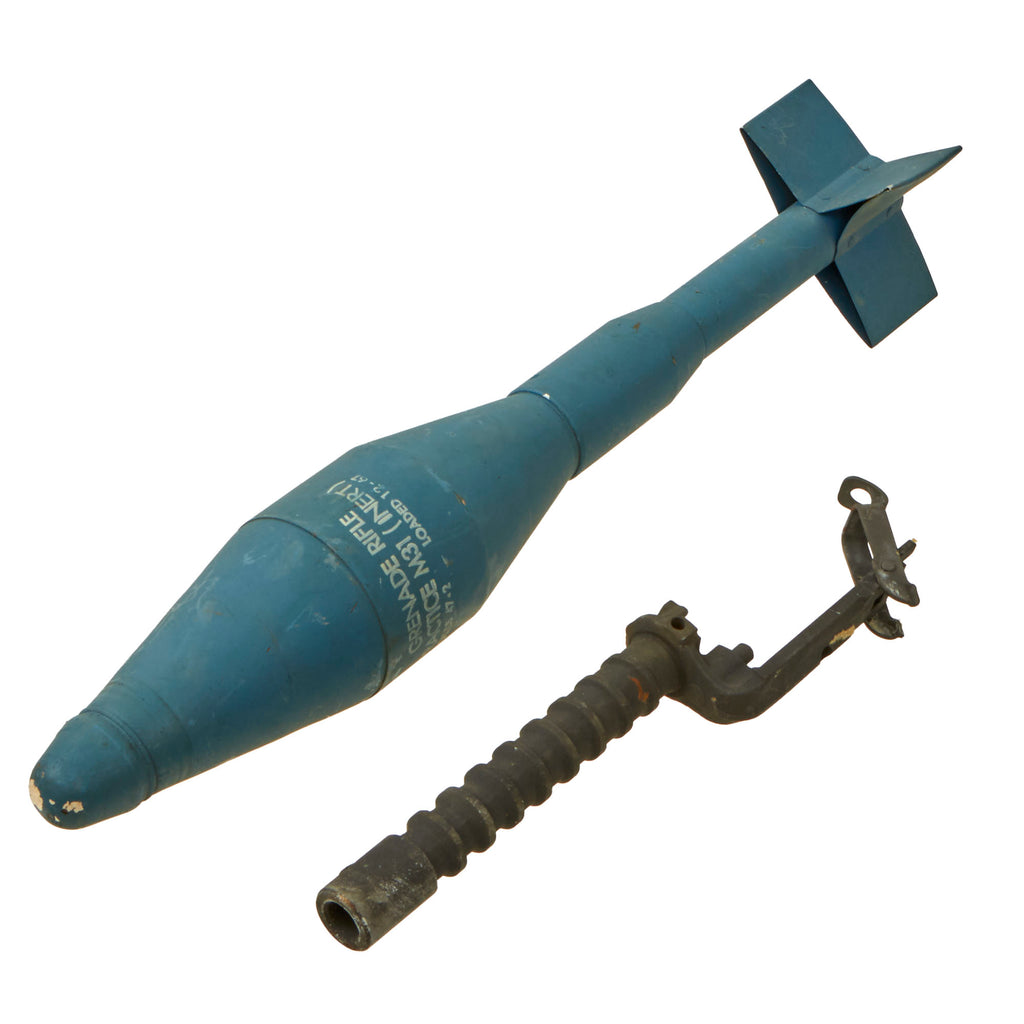Item Description
Original Items: Only One Lot Available. This lot consists of a July, 1961 Dated M-31 Anti Tank Grenade and a rare, seldom found M7A3 Rifle Grenade Launcher for the M1 Garand Rifle. The M7A3s are very hard to come by, and the example we have available to offer is in very good original condition. The launcher is marked “ LAUNCHER GRENADE M7A3” on one side of the base, and “SR 7266167” on the opposite. These launchers are a “must have” for the serious US Weapons collector or M1 Garand enthusiast!
A rifle grenade is a grenade that uses a rifle-based launcher to permit a longer effective range than would be possible if the grenade were thrown by hand. The practice of projecting grenades with rifle-mounted launchers was first widely used during World War I and World War II and continues to the present, with the term "rifle grenade" now encompassing many different types of payloads including high explosive, fragmentation, anti-tank warheads, concussion, smoke, incendiary, and flare missiles. Rifle grenades have largely been supplanted in the infantry fire support role by a combination of grenade launchers (typically affixed to rifles) and disposable anti-armor rockets.
Unloaded or dummy grenades, artillery shell casings, and similar devices, which are cut or drilled in an BATF-approved manner so that they cannot be used as ammunition components for destructive devices, are not considered NFA weapons. This example is in total compliance and is NOT AVAILABLE FOR EXPORT.
The M7A3 Grenade Launcher
M7A3 (ordnance part No. 7266167) [September, 1952 - 1961]: During the Korean War, it was found that World War II-era anti-tank grenades were useless against the Soviet T-34 tanks fielded by the North Korean Army. A new high-velocity anti-tank rifle grenade called the Mecar ENERGA (dubbed the M28 in US Army service) was soon issued. However, its grenade launcher (dubbed the T119) had the same problems as the original M7 launcher and the M28 was inaccurate when launched from the M7A2. The M7A2 launcher was simply redesigned with a longer tube to fire the improved grenades and could be used with either the "flat edge" or "high hump" lock. After the war (from early 1956 to late 1959) it could be fitted with a leaf-sight that was calibrated for use with the M28. The M7A3 kit (ordnance part No. 5750089) consisted of a M7A3 launcher packed with a "high hump" gas lock to allow the grenadier to upgrade an earlier model M1 Garand to the new specification.
The M31 Anti-Tank Grenade
The M31 was originally designed to be fired only from the M1 Garand, but could also be fired from both the M14 and M16 rifles.
To launch the M31, a detachable spigot-type grenade launcher (M7A3 launcher for M1 rifle, and M76 launcher for the M14 rifle) is fitted to the muzzle of the rifle. A M3 ballistic cartridge (two are supplied in the packing container with each grenade and are crimped to indicate the cartridges are only for launching rifle grenades) is loaded into the rifle's chamber. The hollow tail unit of the rifle grenade is fitted over the grenade launcher.
Official military manuals recommend that the M31 HEAT be fired from either the standing or kneeling position and that it is only accurate against armored vehicles if fired at extremely close ranges. While claimed to be effective against main battle tanks (except in frontal engagements) and lightly armored vehicles when first introduced, in 1972 the US Army stated in its revised anti-armor warfare manual that the M31 HEAT was only effective against light tanks and thin-skinned vehicles.
Design
On impact, the nose cover collapses, crushing a crystal-like material, which sends an electric current through a separate wire to the warhead's detonator, located in the base of the warhead. A mechanical safety, comprising a set back system located in the warhead's base, grounds the firing circuit and prevents the accidental explosion of the warhead. On firing, the sudden launch acceleration causes the set-back's three disks to rotate 90 degrees, each in succession to the other, with the rotation of the third disk removing the grounding after approximately 10 meters of flight and completing a firing circuit for the current to flow from the nose to the detonator in the base. Compared to the ENERGA, the M31 is slightly lighter in weight and has a smaller-diameter warhead—i.e. 75mm vs 66mm. Penetration for the M31 is estimated to be 200 mm / 8 inches for steel armor plating and twice that estimate for concrete. The warhead technology developed for the M31 was used for the future M72 LAW anti tank rocket.
Status
Various US military manuals issued in 1972 still had sections on the M31, but by the end of the Vietnam War, both the US Army and US Marines had essentially phased out muzzle-launched rifle grenades, in favor of the M72 LAW disposable rocket in the anti-armor role and the M203 under-barrel grenade launcher in the squad fire-support role.
In the 1977 revision of US military anti-armor warfare manuals, the M31 HEAT was no longer listed.
The 2001 U.S. Army TM 43-0001-29 C2, "Data Sheets for Grenades" details the Grenade, Rifle, HEAT M31 on pages 3-3 and 3-4 with DODIC ordering codes.
- This product is not available for international shipping.
- NOTE: All Muskets, Rifles, Display Machine Guns, Machine Gun Part Sets and any firearm sold by I.M.A are non-firing and completely inoperable or were manufactured before 1898 and deemed "Antique Firearms". All items are LEGAL and authorized by the U.S. BUREAU OF ALCOHOL, T0BACCO AND FIREARMS for sale, ownership, and trade within the UNITED STATES OF AMERICA. IMA does not violate International or individual state laws, and sells accordingly.
- Not eligible for payment with Paypal or Amazon















